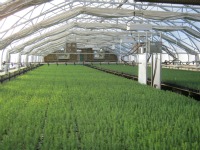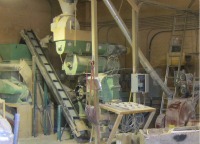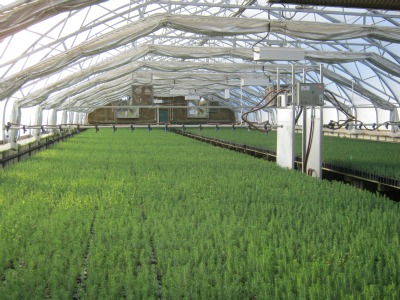
Newfoundland sees pellet potential
October 25, 2010
By Gordon Murray | WPAC
 |
 |
|
| Exploits Pelletizing is a small pellet producer in Bishop's Falls, Newfoundland.
|
Oct. 25, 2010 – As executive
director of the Wood Pellet Association of Canada, I attended the Newfoundland
Pellet Conference, held October 12-15, 2010, in Gander. It was hosted by the
Province of Newfoundland and Labrador, the Canadian Institute of Forestry, and
Canbio. Two days of presentations were followed by a field trip to two sites:
the provincial Woodale Tree Nursery, which is the site of a planned pellet
boiler installation for greenhouse heating; and Exploits Pelletizing, a small
plant in Bishop’s Falls.
The Newfoundland and Labrador
government is keen to develop a wood pellet industry in the province. The
government has assigned an assistant deputy minister, Phil McCarthy, whose
full-time job is to promote the provincial biofuel agenda. Eric Young,
director; and Gary Forward, manager of industry transition—both with the
Department of Natural Resources, Forest Services Branch—organized the
conference and are enthusiastic supporters of potential wood pellet
manufacturing and consumption in Newfoundland and Labrador.
Some of my observations and
conclusions from the conference are as follows.
·
There
are presently three pellet plants in Newfoundland, with combined annual
capacity of about 60,000 tonnes. Cottles Island’s capacity (Summerford, 60 km
north of Gander) is about 10,000 tonnes and is targeting Atlantic Canada and
U.S. markets. Exploits Pelletizing (Bishops Falls, 65 km west of Gander)
produces about 1500 tonnes annually for sale locally in central Newfoundland.
Holson Forest Products is close to commissioning a 50,000-tonne/year plant in
Roddickton, at the remote end of the Northern Peninsula (250 km north of Corner
Brook), and intends for Europe to be its primary market.
·
The
existing total annual Newfoundland pellet market is just 3000 tonnes. There is
one large oil-fired power plant that could be converted to pellets (potential
750,000 tonnes/year), but will likely close if the province goes ahead with the
Lower Churchill hydroelectric project. The potential domestic heating market is
surprisingly large. Annual energy used for residential heating is as follows:
(1) heating oil, 4.2 petajoules (1 PJ = 1 million GJ); (2) electricity, 7.2 PJ; and (3)
cordwood, 3.1 PJ; for a total of 14.5 PJ. At 19 GJ/tonne, this translates to a
potential market for 736,000 tonnes of wood pellets.

|
|
| Woodale Tree Nursery is the site of a planned pellet boiler installation for greenhouse heating. |
·
The
province has subsidy program to incentivize the purchase of residential and
commercial pellet heating systems. In 2009, the average subsidy for a home
heating system was approximately $600 for an average system cost of $2300.
Clarence Waldner of Decker Boilers opined that pellets are superior to chips
for commercial boilers.
·
Until
recently, Newfoundland had three pulp mills: two owned by Abitibi (in
Stephenville and Windsor-Grand Falls) and one owned by Kruger (in Corner
Brook). Both Abitibi mills have closed permanently. The province expropriated
the mill, timberlands, and hydro power plants from Abitibi’s Windsor-Grand
Falls operation. The Kruger mill is now operating just two of four machines and
this will likely be permanent. Evidently, Kruger is able to supply sufficient
power from its own biomass cogeneration plant (Editor's note: see Canadian Biomass March/April 2010: Feeding Frenzy) for two
machines and has to purchase unaffordable energy from the grid if it wants to
operate all four machines.
·
The
Kruger boilers were formerly fueled by bunker C heating oil, which has been
phased out. Kruger now uses predominantly biomass fuel, with a small quantity
of recycled motor oil to supplement.
·
The
allowable cut in NL exceeds 2.3 million m3. Only 1,000,000 m3
is being used. In 2009, the province requested proposals to use the balance of
the annual allowable cut. The proposals received were not satisfactory, and
there likely remains an opportunity to obtain substantial Crown timber, subject
to a workable business plan. The government presents itself as being
business-friendly.
·
Total
sawmill capacity is approximately 70 million board feet. One mill, Sexton,
produces 50 million bf, and three others collectively produce 20 million bf.
The province has concluded that the sawmill industry will not survive without a
market for small logs and sawmill residuals.
·
Species
are about 95% coniferous (black spruce, balsam fir, eastern larch) and 5%
deciduous (birch). From what I could see, logging and road construction would
be similar to the Interior Plateau of British Columbia and Alberta, i.e., flat,
easy road building, 100% mechanical.
·
There
are deep-sea ports with good facilities at Corner Brook and Botwood (near
Windsor-Grand Falls). Newfoundland is the closest province to Europe. This
should be of interest to large British Columbia producers (who presently ship
from Canada’s west coast via the Panama Canal) or to European power producers
seeking vertical integration.
·
Although
the province’s forests are sustainably managed by professional foresters, they
are not third-party certified. The province has recognized that this issue must
be addressed so as to open and maintain market access.
Print this page